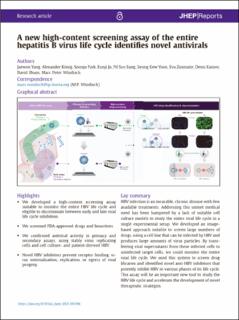| dc.contributor.author | Yang, Jaewon | |
| dc.contributor.author | König, Alexander | |
| dc.contributor.author | Park, Soonju | |
| dc.contributor.author | Jo, Eunji | |
| dc.contributor.author | Sung, Pil Soo | |
| dc.contributor.author | Yoon, Seung Kew | |
| dc.contributor.author | Zusinaite, Eva | |
| dc.contributor.author | Kainov, Denis | |
| dc.contributor.author | Shum, David | |
| dc.contributor.author | Windisch, Marc Peter | |
| dc.date.accessioned | 2023-01-23T08:20:33Z | |
| dc.date.available | 2023-01-23T08:20:33Z | |
| dc.date.created | 2021-12-14T10:39:21Z | |
| dc.date.issued | 2021 | |
| dc.identifier.citation | JHEP Reports. 2021, 3 (4), . | en_US |
| dc.identifier.uri | https://hdl.handle.net/11250/3045132 | |
| dc.description.abstract | Background & Aims: Chronic hepatitis B is an incurable disease. Addressing the unmet medical need for therapies has been hampered by a lack of suitable cell culture models to investigate the HBV life cycle in a single experimental setup. We sought to develop a platform suitable to investigate all aspects of the entire HBV life cycle. Methods: HepG2-NTCPsec+ cells were inoculated with HBV. Supernatants of infected cells were transferred to naïve cells. Inhibition of infection was determined in primary and secondary infected cells by high-content imaging of viral and cellular factors. Novel antivirals were triaged in cells infected with cell culture- or patient-derived HBV and in stably virus replicating cells. HBV internalisation and target-based receptor binding assays were conducted. Results: We developed an HBV platform, screened 2,102 drugs and bioactives, and identified 3 early and 38 late novel HBV life cycle inhibitors using infectious HBV genotype D. Two early inhibitors, pranlukast (EC50 4.3 μM; 50% cytotoxic concentration [CC50] >50 μM) and cytochalasin D (EC50 0.07 μM; CC50 >50 μM), and 2 late inhibitors, fludarabine (EC50 0.1 μM; CC50 13.4 μM) and dexmedetomidine (EC50 6.2 μM; CC50 >50 μM), were further investigated. Pranlukast inhibited HBV preS1 binding, whereas cytochalasin D prevented the internalisation of HBV. Fludarabine inhibited the secretion of HBV progeny DNA, whereas dexmedetomidine interfered with the infectivity of HBV progeny. Patient-derived HBV genotype C was efficiently inhibited by fludarabine (EC50 0.08 μM) and dexmedetomidine (EC50 8.7 μM). Conclusions: The newly developed high-content assay is suitable to screen large-scale drug libraries, enables monitoring of the entire HBV life cycle, and discriminates between inhibition of early and late viral life cycle events. | en_US |
| dc.language.iso | eng | en_US |
| dc.publisher | Elsevier B. V. | en_US |
| dc.rights | Attribution-NonCommercial-NoDerivatives 4.0 Internasjonal | * |
| dc.rights.uri | http://creativecommons.org/licenses/by-nc-nd/4.0/deed.no | * |
| dc.title | A new high-content screening assay of the entire hepatitis B virus life cycle identifies novel antivirals | en_US |
| dc.title.alternative | A new high-content screening assay of the entire hepatitis B virus life cycle identifies novel antivirals | en_US |
| dc.type | Peer reviewed | en_US |
| dc.type | Journal article | en_US |
| dc.description.version | publishedVersion | en_US |
| dc.source.pagenumber | 14 | en_US |
| dc.source.volume | 3 | en_US |
| dc.source.journal | JHEP Reports | en_US |
| dc.source.issue | 4 | en_US |
| dc.identifier.doi | 10.1016/j.jhepr.2021.100296 | |
| dc.identifier.cristin | 1968127 | |
| cristin.ispublished | true | |
| cristin.fulltext | original | |
| cristin.qualitycode | 1 | |

